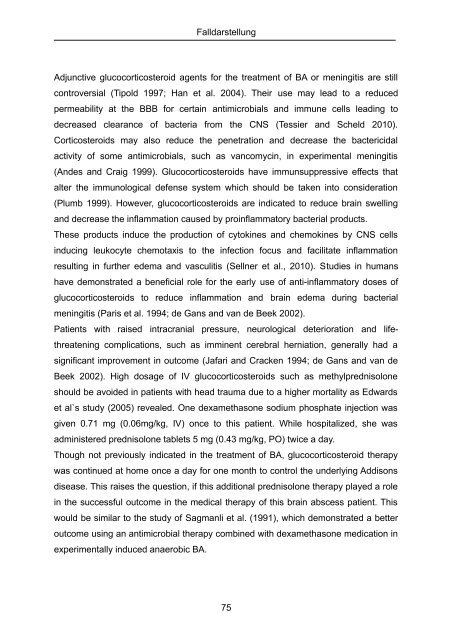TiHo Bibliothek elib - Tierärztliche Hochschule Hannover
TiHo Bibliothek elib - Tierärztliche Hochschule Hannover
TiHo Bibliothek elib - Tierärztliche Hochschule Hannover
Create successful ePaper yourself
Turn your PDF publications into a flip-book with our unique Google optimized e-Paper software.
Falldarstellung<br />
Adjunctive glucocorticosteroid agents for the treatment of BA or meningitis are still<br />
controversial (Tipold 1997; Han et al. 2004). Their use may lead to a reduced<br />
permeability at the BBB for certain antimicrobials and immune cells leading to<br />
decreased clearance of bacteria from the CNS (Tessier and Scheld 2010).<br />
Corticosteroids may also reduce the penetration and decrease the bactericidal<br />
activity of some antimicrobials, such as vancomycin, in experimental meningitis<br />
(Andes and Craig 1999). Glucocorticosteroids have immunsuppressive effects that<br />
alter the immunological defense system which should be taken into consideration<br />
(Plumb 1999). However, glucocorticosteroids are indicated to reduce brain swelling<br />
and decrease the inflammation caused by proinflammatory bacterial products.<br />
These products induce the production of cytokines and chemokines by CNS cells<br />
inducing leukocyte chemotaxis to the infection focus and facilitate inflammation<br />
resulting in further edema and vasculitis (Sellner et al., 2010). Studies in humans<br />
have demonstrated a beneficial role for the early use of anti-inflammatory doses of<br />
glucocorticosteroids to reduce inflammation and brain edema during bacterial<br />
meningitis (Paris et al. 1994; de Gans and van de Beek 2002).<br />
Patients with raised intracranial pressure, neurological deterioration and lifethreatening<br />
complications, such as imminent cerebral herniation, generally had a<br />
significant improvement in outcome (Jafari and Cracken 1994; de Gans and van de<br />
Beek 2002). High dosage of IV glucocorticosteroids such as methylprednisolone<br />
should be avoided in patients with head trauma due to a higher mortality as Edwards<br />
et al`s study (2005) revealed. One dexamethasone sodium phosphate injection was<br />
given 0.71 mg (0.06mg/kg, IV) once to this patient. While hospitalized, she was<br />
administered prednisolone tablets 5 mg (0.43 mg/kg, PO) twice a day.<br />
Though not previously indicated in the treatment of BA, glucocorticosteroid therapy<br />
was continued at home once a day for one month to control the underlying Addisons<br />
disease. This raises the question, if this additional prednisolone therapy played a role<br />
in the successful outcome in the medical therapy of this brain abscess patient. This<br />
would be similar to the study of Sagmanli et al. (1991), which demonstrated a better<br />
outcome using an antimicrobial therapy combined with dexamethasone medication in<br />
experimentally induced anaerobic BA.<br />
75










![Tmnsudation.] - TiHo Bibliothek elib](https://img.yumpu.com/23369022/1/174x260/tmnsudation-tiho-bibliothek-elib.jpg?quality=85)





